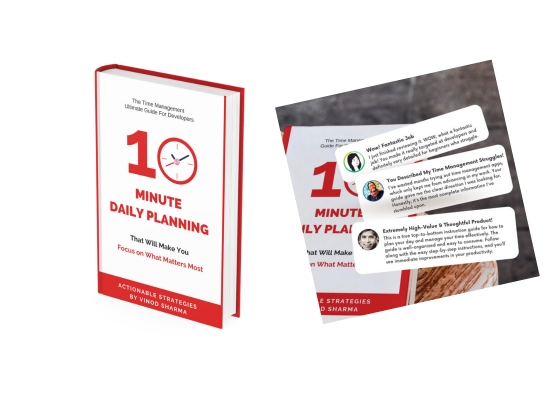I'm a published author, with my book, 10-Minute Daily Planning For Developers, available on Amazon. The journey from idea to published book taught me more about writing, persistence, and entrepreneurship than I expected.
In this comprehensive guide, I'll share exactly how I did it, including the steps I took, the tools I used, the mistakes I made, and what I'd do differently next time.
If you've ever thought about writing a book but didn't know where to start, this is your roadmap.
The Foundation: Building a Daily Writing Habit
Starting with Ship 30 for 30
My book journey actually began with Ship 30 for 30, a course that teaches you to write "atomic essays," 500-word articles designed for X. The course emphasizes daily writing practice and publishing your work consistently.
Key lessons from Ship 30 for 30:
- Write every single day, no exceptions
- Publish everything (even imperfect pieces)
- Atomic essays are building blocks for longer content
- Audience feedback guides your best ideas
After completing the 30-day program, I continued writing daily on Twitter/X. This habit became the foundation for my book.
Why this approach worked:
- Low pressure: 500 words daily is manageable
- Immediate feedback: Social media responses showed what resonated
- Content library: I was unknowingly creating book chapters
- Writing confidence: Daily practice removed the fear of the blank page
Identifying Your Book Idea Through Audience Response
After 2-3 months of daily writing, patterns emerged.
My posts about productivity, time management, and developer workflows consistently got the most engagement. Comments like "I need this as a longer guide" and "Do you have more content like this?" told me I'd found my book topic.
How to spot your book idea:
- Track which posts get the most saves/shares
- Notice recurring questions in comments
- Identify topics you naturally return to
- Look for content that people request "more of"
Creating Your Book Outline
Once I identified "daily planning for programmers" as my topic, I created a comprehensive outline using ChatGPT and my existing content.
My outline creation process:
- Copy all my atomic essays related to time management, goal setting and daily planning in the Notion
- Brain dump additional ideas (30 minutes)
- Group similar concepts into potential chapters
- Use ChatGPT to refine the structure with this prompt:
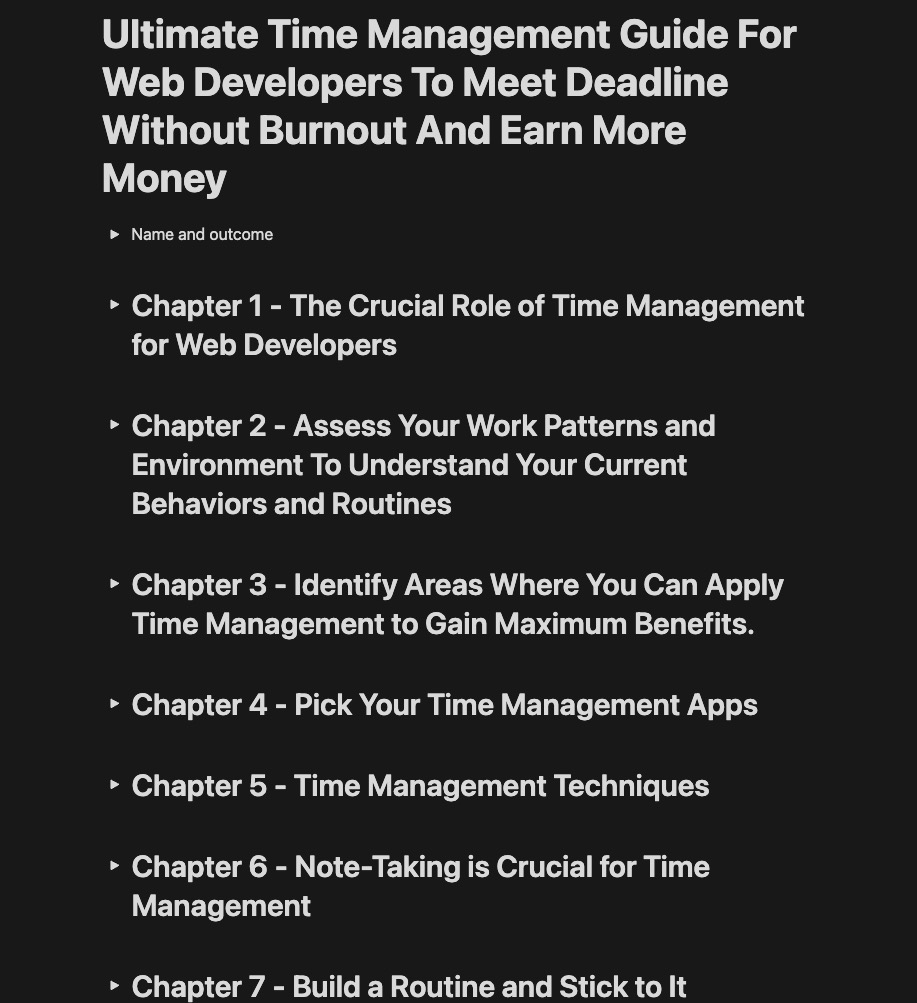
You are an expert book publishing coach, and I’ve hired you to guide me through writing a book. My target audience is busy software developers, and the book's focus is on daily planning strategies tailored for programmers. Here’s what I need from you: Help me turn my core ideas [insert your list] into a clear, logical chapter structure. The structure should be easy to follow, respect developers’ limited time, and deliver practical, actionable insights. Each chapter should build on the previous one and support a natural flow from start to finish. Let’s begin by organizing the content into a compelling outline.
- Break each chapter into sections (3-5 per chapter)
- Map existing content to outline sections
My book's initial structure:
- Chapter 1: The Crucial Role of Time Management for Web Developers
- Chapter 2: Assess Your Work Patterns and Environment To Understand Your Current Behaviors and Routines
- Chapter 3: Identify Areas Where You Can Apply Time Management to Gain Maximum Benefits
- Chapter 4: Pick Your Time Management Apps
- Chapter 5: Time Management Techniques
- Chapter 6: Note-Taking is Crucial for Time Management
- Chapter 7: Build a Routine and Stick to It
- Chapter 8: Minimize Distractions and Interruptions
- Chapter 9: Take Regular Breaks and Practice Self-Care
- Chapter 10: Collaborate Effectively with Your Team
- Chapter 11: Measure Your Progress and Adjust Your System as Needed
- Chapter 12: Adapt and Adjust Your Time Management System
- Chapter 13: Best Home Office Gadgets to Dramatically Enhance Your Work
- That’s a wrap
My book's final structure:
- Chapter 1 Introduction
- Chapter 2 Benefits of Effective Time Management For Developers
- Chapter 3 Assessing Your Work Patterns and Routines
- Chapter 4 Plan Your Day Effectively
- Chapter 5 Follow Your Plan Throughout The Day
- Chapter 6 Structuring Your Day With Mastering & Evening Routines
- Chapter 7 Maximizing Progress with a Weekly Review
- Chapter 8 Strategies to Maximize Focus and Minimize Distractions
- Chapter 9 The Power of Breaks and Self-Care 47
- Chapter 10 Mastering the Art of Note-Taking is Crucial for Time... 55
- Chapter 11 Harnessing the Power of Time Management Apps
- Chapter 12 Measure Your Progress and Adjust Your System as Needed
Content Mapping and Gap Analysis
I reviewed my 60+ atomic essays and mapped them to my outline. This revealed:
- 40% of existing content that could be expanded
- 60% new content needed to complete the book
- Clear content gaps that became my daily writing targets
The Daily Writing System That Actually Works
The One Sub-Chapter-Per-Day Approach
Instead of writing the book linearly, I used this system:
Daily writing routine:
- Choose one section from my outline
- Write 500-800 words on that topic
- Publish as a tweet thread or LinkedIn post first
- Get immediate feedback from the audience
- Refine and expand based on responses
- Add to book draft in Reedsy
This approach had multiple benefits:
- Content validation before including in the book
- Continuous audience building while writing
- Natural editing process through social feedback
- Reduced perfectionism (already published = good enough)
Tools That Made Writing Seamless
Primary writing tool: Reedsy
- Free book writing and formatting platform
- Professional templates for different genres
- Export to multiple formats (PDF, EPUB, MOBI, Word)
- Built-in collaboration features
- Chapter organization and navigation
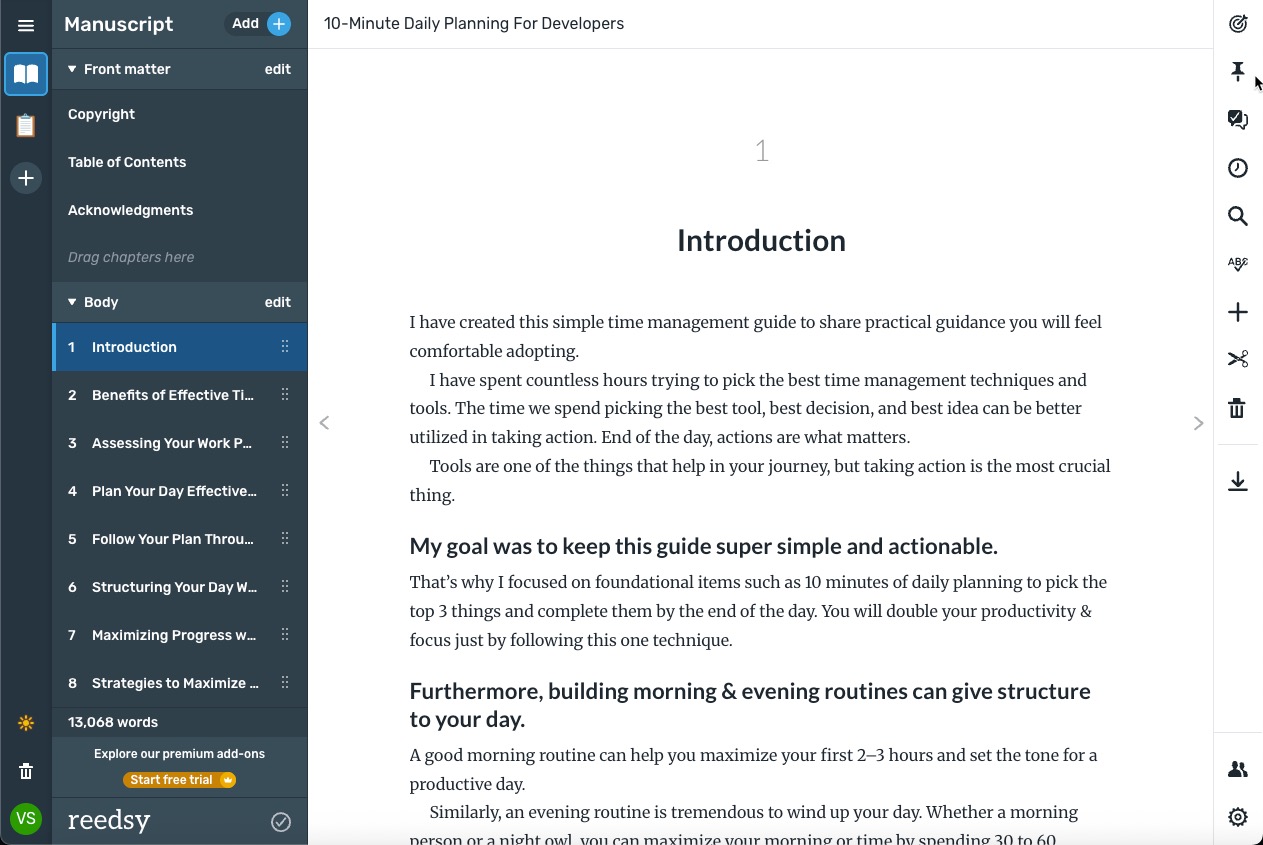
Why Reedsy over other tools:
- Designed specifically for book writing
- Handles formatting automatically
- Free tier includes everything you need
- Professional output quality
- Easy export for publishing platforms
Supporting tools:
- ChatGPT: Outline creation, content expansion, editing suggestions
- Grammarly: Grammar and style checking
- Google Docs: Collaborative editing with beta readers
- Canva: Cover design and graphics
The Editing Process: From 170 Pages to 90 Pages
The Three Major Reorganizations
I reorganized my book structure three times as the content evolved:
- First draft: Chronological approach (morning to evening planning)
- Second draft: Tool-focused approach (apps, systems, techniques)
- Final draft: Problem-solution approach (challenges developers face + solutions)
Each reorganization made the book more focused and valuable to readers.
The Painful but Necessary Cutting Process
At one point, my book was 170 pages. I knew this was too long for a practical guide, so I started cutting ruthlessly.
Cutting criteria:
- Does this fit the book's core promise?
- Would removing this hurt the overall flow?
- Does this directly solve the reader's problem?
Content I removed:
- Detailed app reviews (dated quickly)
- Note-taking strategies that were not directly related to the core idea
- Personal stories that didn't teach lessons
- Redundant examples and explanations
- Collaborate effectively with your team
- Home office gadgets to enhance your work
Final result: 90 pages of focused, actionable content
Getting Feedback That Actually Helps
I got feedback from three types of people:
- Target readers (developers): Focused on practical value
- Writing friends: Focused on structure and flow
- Non-technical readers: Focused on clarity and accessibility
Best feedback questions:
- "What's the one thing you'd implement immediately?"
- "Where did you get confused or lose interest?"
- "What's missing that you expected to find?"
- "Would you recommend this to a colleague?"
Cover Design: Professional Results on a Budget
DIY Design with Canva
I created my initial cover design in Canva using their book cover templates:
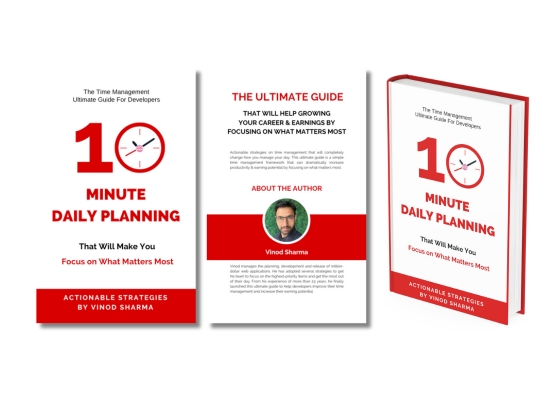
Design principles I followed:
- Clear, readable title (visible as thumbnail)
- Subtitle that explains the benefit ("Save Time, Reduce Stress, Ship More Code")
- Professional color scheme (blues and grays for tech audience)
- Minimal design (no cluttered graphics)
Canva Pro features that helped:
- Brand kit for consistent colors
- Magic resize for different formats
- Background remover for clean graphics
- Professional fonts included
Professional Formatting via Fiverr
While my Canva design looked good, Amazon has specific technical requirements for print books. I hired a designer on Fiverr ($25) to:
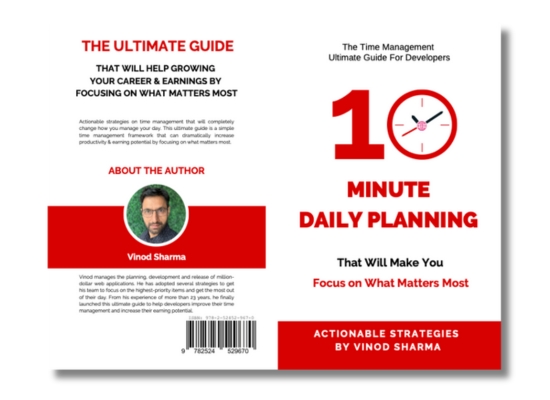
- Convert my design to Amazon's template specifications
- Add an ISBN barcode on the back cover
- Create spine design for print version
- Ensure proper bleed and margins
- Provide files in required formats
What to look for in a Fiverr designer:
- Specific experience with Amazon KDP
- Portfolio showing book covers in your genre
- High ratings and recent reviews
- Clear communication about requirements
The ISBN Decision: Amazon vs. Independent
Amazon offers two paths for ISBN (International Standard Book Number):
Amazon's free ISBN:
- ✅ No cost
- ✅ Immediate availability
- ❌ Locks you into Amazon ecosystem
- ❌ Amazon listed as publisher
- ❌ Can't distribute elsewhere easily
Your own ISBN:
- ✅ You're listed as publisher
- ✅ Can distribute anywhere
- ✅ More professional appearance
- ❌ Costs $50-300+ depending on source
- ❌ Additional complexity
My ISBN Strategy (And What I'd Do Differently)
I chose to buy my own ISBN for future flexibility. I found a seller on eBay offering 5 ISBNs for $20 (compared to $125 for one from Bowker, the official US source).
Risks of cheap ISBNs:
- Potential duplicate assignments
- No guarantee of legitimacy
- Limited customer support
My recommendation now: Start with Amazon's free ISBN for your first book. If it succeeds and you want to expand distribution, buy official ISBNs for future books.
Amazon KDP: Publishing Step-by-Step
Setting Up Your Publisher Account
I created a separate Amazon account specifically for publishing (distinct from my affiliate account) to keep business activities organized.
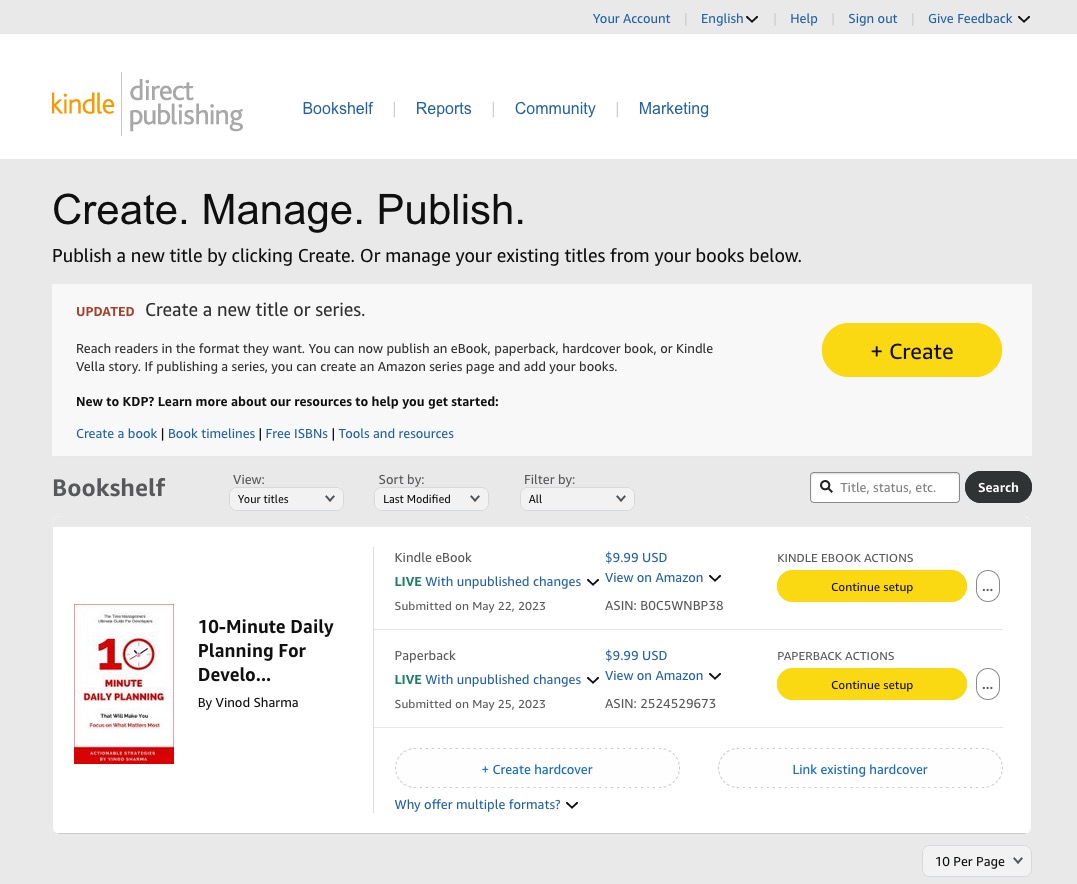
Account setup steps:
- Go to kdp.amazon.com
- Create new account or sign in
- Complete tax information (important for payments)
- Verify identity with government ID
- Set up payment method for royalties
Book Details and Metadata
Critical information you'll need:
- Title and subtitle (exactly as on your cover)
- Book description (this is your sales page)
- Keywords (how people find your book)
- Categories (where your book appears in Amazon)
- Age and grade range (if applicable)
Keywords that worked for my book:
- "productivity for developers"
- "time management programming"
- "daily planning software engineers"
- "developer productivity"
- "programmer work-life balance"
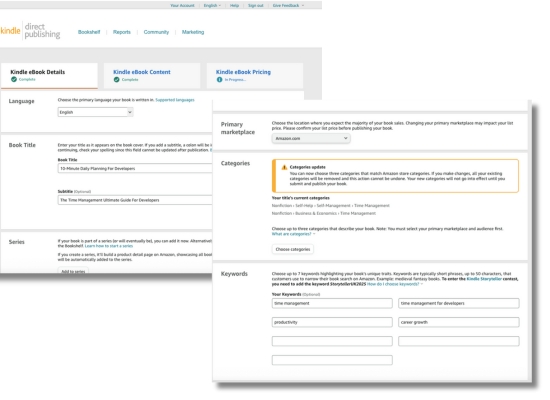
Pricing Strategy and Royalty Options
Amazon offers two royalty structures:
35% royalty:
- ✅ Can price as low as $0.99
- ✅ Available in all territories
- ❌ Lower earnings per sale
70% royalty:
- ✅ Much higher earnings
- ❌ Must price between $2.99-$9.99
- ❌ Limited territories
- ❌ Amazon deducts delivery costs
My pricing strategy:
- Ebook: $9.99 (70% royalty = $6.99 per sale)
- Paperback: $9.99 (60% royalty after printing costs = ~$5.99 per sale)
The Review and Publishing Process
After uploading everything:
- Amazon review: 24-72 hours for content and format check
- Approval notification: Email when live
- Search visibility: Takes 2-5 days to appear in searches
- Global distribution: Up to 2 weeks for all Amazon stores
Marketing: What Worked (And What Didn't)
Social Media Launch Strategy
Twitter/X campaign:
- Announcement thread with book journey story
- Daily quotes/tips from the book for 2 weeks
- Behind-the-scenes content about writing process
- Engagement with comments and shares
LinkedIn strategy:
- Professional article about productivity
- Connection outreach to developers in my network
- Comments on productivity-related posts
- Updates in relevant LinkedIn groups
Results:
- 10+ book sales in first month
- 20+ organic shares and mentions
- Two speaking opportunities
What I'd Do Differently
Bigger email list: I initially had only 200 email subscribers. Building this to 1,000+ before publishing would have made a big difference.
Pre-launch buzz: Start talking about your book 2-3 months before publishing, not just at launch.
Content marketing: Create more free valuable content (blog posts, videos) that naturally leads to the book.
Podcast outreach: Pitch yourself as a guest on productivity and developer podcasts.
Community engagement: Be more active in relevant Reddit communities, Discord servers, and forums.
The Numbers: Costs, Earnings, and Time Investment
Financial Breakdown
Total costs:
- ISBN numbers: $20
- Cover design: $25
- Editing software: $0 (free tools)
- Marketing: $0 (organic only)
- Total investment: $45
Revenue (first 6 months):
- Ebook sales: $89 (20 copies × $4.49 average)
- Paperback sales: $12.5 (5 copies × $2.50 average)
- Total revenue: $101
- Net profit: $56
Time Investment
Writing phase: 60 hours over 3 months
- Daily writing: 30 minutes × 90 days = 45 hours
- Editing and reorganizing: 15 hours
Publishing preparation: 20 hours over 2 weeks
- Cover design and formatting: 8 hours
- Amazon setup and uploads: 6 hours
- Final proofing and adjustments: 6 hours
Marketing and promotion: 30 hours over 6 months
- Social media content: 20 hours
- Community engagement: 10 hours
Total time investment: 110 hours
Tools and Resources Roundup
Essential Free Tools
- Book writing and formatting
- Free templates and exports
- Professional-quality output
- Cover design templates
- Free graphics and fonts
- Easy-to-use design tools
- Outline creation and refinement
- Content expansion and improvement
- Editing suggestions and grammar help
- Free publishing platform
- Global distribution
- Print-on-demand services
Paid Tools Worth Considering
Grammarly Pro ($12/month)
- Advanced grammar and style checking
- Tone and clarity suggestions
- Plagiarism detection
Professional editor ($500-2,000)
- Developmental editing for structure
- Copy editing for grammar and flow
- Proofreading for final polish
Learning Resources
- Daily writing habit formation
- Atomic essay framework
- Community support and feedback
"On Writing" by Stephen King
- Practical writing advice
- Author mindset and discipline
- Honest look at the writing process
"Platform" by Michael Hyatt
- Building audience before launching
- Marketing strategies for authors
- Long-term platform development
Common Pitfalls and How to Avoid Them
Writing Phase Mistakes
-
Perfectionism paralysis: Don't edit while writing your first draft. Get the full story down, then improve it.
-
Scope creep: Stick to your outline. New ideas can go in a future book or blog post.
-
Isolation writing: Share excerpts with your audience for feedback and validation.
Publishing Phase Mistakes
-
Rushing the cover: This is your marketing material. Invest time and/or money to make it professional.
-
Ignoring keywords: Amazon is a search engine. Research what your target readers actually search for.
-
Wrong pricing: Too low devalues your work; too high limits discoverability. Research similar books.
Marketing Phase Mistakes
-
Launch and disappear: Book marketing is ongoing, not a one-week event.
-
Selling instead of helping: Share valuable content that naturally leads to your book.
-
Ignoring reviews: Respond to reviews (especially negative ones) professionally and helpfully.
Your Action Plan: Getting Started This Week
Week 1: Foundation Building
Day 1-2: Validate Your Idea
- Review your existing content for popular themes
- Survey your audience about pain points
- Research existing books in your niche
- Identify your unique angle or approach
Day 3-4: Create Your Outline
- Brain dump all related ideas and concepts
- Group ideas into logical chapters
- Break chapters into 3-5 sections each
- Use ChatGPT to refine structure and flow
Day 5-7: Set Up Your Writing System
- Create Reedsy account and start new project
- Set up daily writing schedule (same time each day)
- Prepare research materials and resources
- Write your first 500-word section
Week 2-4: Content Creation Sprint
Daily routine:
- Write one book section (500-800 words)
- Publish adapted version on social media
- Collect feedback and engagement data
- Add refined version to your book draft
Weekly tasks:
- Review and organize completed sections
- Adjust outline based on new insights
- Connect with potential beta readers
- Track progress and maintain momentum
Month 2: Draft Completion and Editing
Week 5-6: Complete First Draft
- Fill in any remaining outline sections
- Write introduction and conclusion
- Do complete read-through for flow
- Identify major structural issues
Week 7-8: Major Editing Round
- Reorganize chapters if needed
- Cut unnecessary content ruthlessly
- Expand thin sections with more value
- Get feedback from beta readers
Month 3: Publishing Preparation
Week 9-10: Final Polish
- Professional editing (or thorough self-edit)
- Format in Reedsy for export
- Create compelling book description
- Research keywords and categories
Week 11-12: Publishing Setup
- Design cover in Canva
- Set up Amazon KDP account
- Upload book files and metadata
- Order proof copy for final review
Month 4+: Launch and Marketing
Launch week:
- Announce on all social platforms
- Email your subscriber list
- Reach out to your network personally
- Engage with comments and shares
Ongoing marketing:
- Create weekly content related to book topics
- Guest posting on relevant blogs
- Podcast outreach and interviews
- Build email list for future books
The Unexpected Benefits of Writing a Book
Beyond the financial returns and author credibility, writing a book delivered unexpected benefits:
Thought leadership: People started viewing me as an expert in productivity and developer workflows.
Business opportunities: Speaking engagements, consulting opportunities, and partnership discussions.
Personal clarity: Writing forced me to articulate my ideas clearly and identify gaps in my thinking.
Community building: The book became a conversation starter and community rallying point.
Skill development: Improved writing, editing, marketing, and project management abilities.
Confidence boost: Completing a book proved I could tackle large, complex projects.
Your Book is Waiting
The gap between "I want to write a book" and "I am a published author" isn't talent, luck, or connections. It's a system, daily practice, and the willingness to share imperfect work to get better.
Your expertise, unique perspective, and experiences are valuable to others. The question isn't whether you have something worth writing about—it's whether you're willing to commit to the daily practice of getting it out of your head and into the world.
The truth about writing a book: It's not about having the perfect idea or being a natural writer. It's about showing up every day, sharing your knowledge, and trusting the process.
Start with one atomic essay today. Pick one thing you know that could help someone else. Write 500 words about it. Publish it. Do it again tomorrow.
Your book is just 90 days of daily writing away.
Ready to start your author journey? I'm here to help. Connect with me on Twitter or LinkedIn if you have questions about the writing or publishing process. I love helping fellow creators turn their knowledge into published books.
Resources mentioned in this article:
- Reedsy - Free book writing platform
- Ship 30 for 30 - Daily writing course
- Amazon KDP - Self-publishing platform
- Canva - Cover design tool
My book: 10-Minute Daily Planning For Developers is available on Amazon in ebook and paperback formats.
